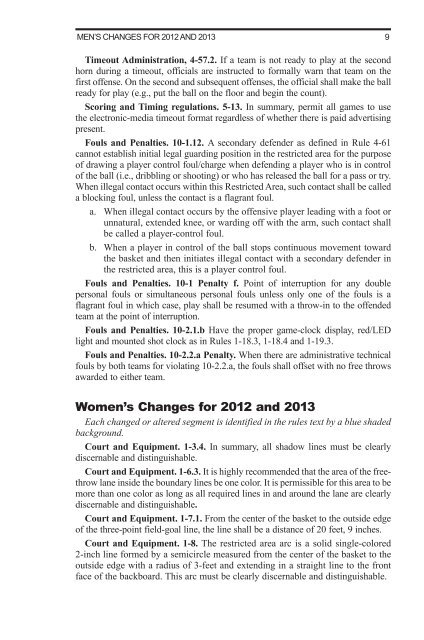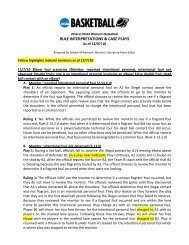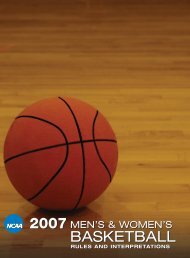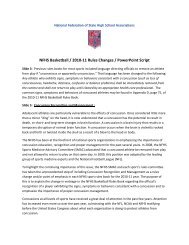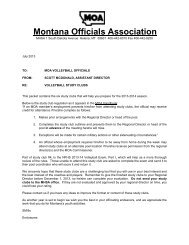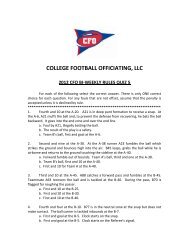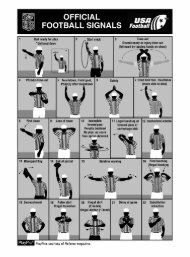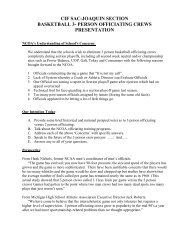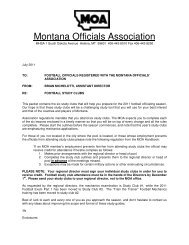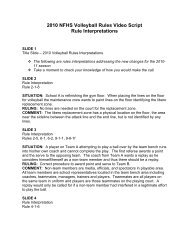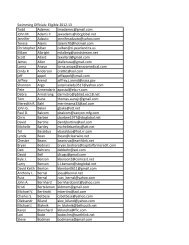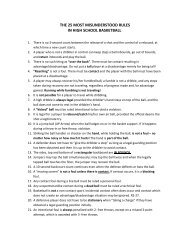2011-12 AND 2012-13 MEN'S AND WOMEN'S RULES - NAIA
2011-12 AND 2012-13 MEN'S AND WOMEN'S RULES - NAIA
2011-12 AND 2012-13 MEN'S AND WOMEN'S RULES - NAIA
You also want an ePaper? Increase the reach of your titles
YUMPU automatically turns print PDFs into web optimized ePapers that Google loves.
Men’s Changes for 20<strong>12</strong> and 20<strong>13</strong>9<br />
Timeout Administration, 4-57.2. If a team is not ready to play at the second<br />
horn during a timeout, officials are instructed to formally warn that team on the<br />
first offense. On the second and subsequent offenses, the official shall make the ball<br />
ready for play (e.g., put the ball on the floor and begin the count).<br />
Scoring and Timing regulations. 5-<strong>13</strong>. In summary, permit all games to use<br />
the electronic-media timeout format regardless of whether there is paid advertising<br />
present.<br />
Fouls and Penalties. 10-1.<strong>12</strong>. A secondary defender as defined in Rule 4-61<br />
cannot establish initial legal guarding position in the restricted area for the purpose<br />
of drawing a player control foul/charge when defending a player who is in control<br />
of the ball (i.e., dribbling or shooting) or who has released the ball for a pass or try.<br />
When illegal contact occurs within this Restricted Area, such contact shall be called<br />
a blocking foul, unless the contact is a flagrant foul.<br />
a. When illegal contact occurs by the offensive player leading with a foot or<br />
unnatural, extended knee, or warding off with the arm, such contact shall<br />
be called a player-control foul.<br />
b. When a player in control of the ball stops continuous movement toward<br />
the basket and then initiates illegal contact with a secondary defender in<br />
the restricted area, this is a player control foul.<br />
Fouls and Penalties. 10-1 Penalty f. Point of interruption for any double<br />
personal fouls or simultaneous personal fouls unless only one of the fouls is a<br />
flagrant foul in which case, play shall be resumed with a throw-in to the offended<br />
team at the point of interruption.<br />
Fouls and Penalties. 10-2.1.b Have the proper game-clock display, red/LED<br />
light and mounted shot clock as in Rules 1-18.3, 1-18.4 and 1-19.3.<br />
Fouls and Penalties. 10-2.2.a Penalty. When there are administrative technical<br />
fouls by both teams for violating 10-2.2.a, the fouls shall offset with no free throws<br />
awarded to either team.<br />
Women’s Changes for 20<strong>12</strong> and 20<strong>13</strong><br />
Each changed or altered segment is identified in the rules text by a blue shaded<br />
background.<br />
Court and Equipment. 1-3.4. In summary, all shadow lines must be clearly<br />
discernable and distinguishable.<br />
Court and Equipment. 1-6.3. It is highly recommended that the area of the freethrow<br />
lane inside the boundary lines be one color. It is permissible for this area to be<br />
more than one color as long as all required lines in and around the lane are clearly<br />
discernable and distinguishable.<br />
Court and Equipment. 1-7.1. From the center of the basket to the outside edge<br />
of the three-point field-goal line, the line shall be a distance of 20 feet, 9 inches.<br />
Court and Equipment. 1-8. The restricted area arc is a solid single-colored<br />
2-inch line formed by a semicircle measured from the center of the basket to the<br />
outside edge with a radius of 3-feet and extending in a straight line to the front<br />
face of the backboard. This arc must be clearly discernable and distinguishable.


